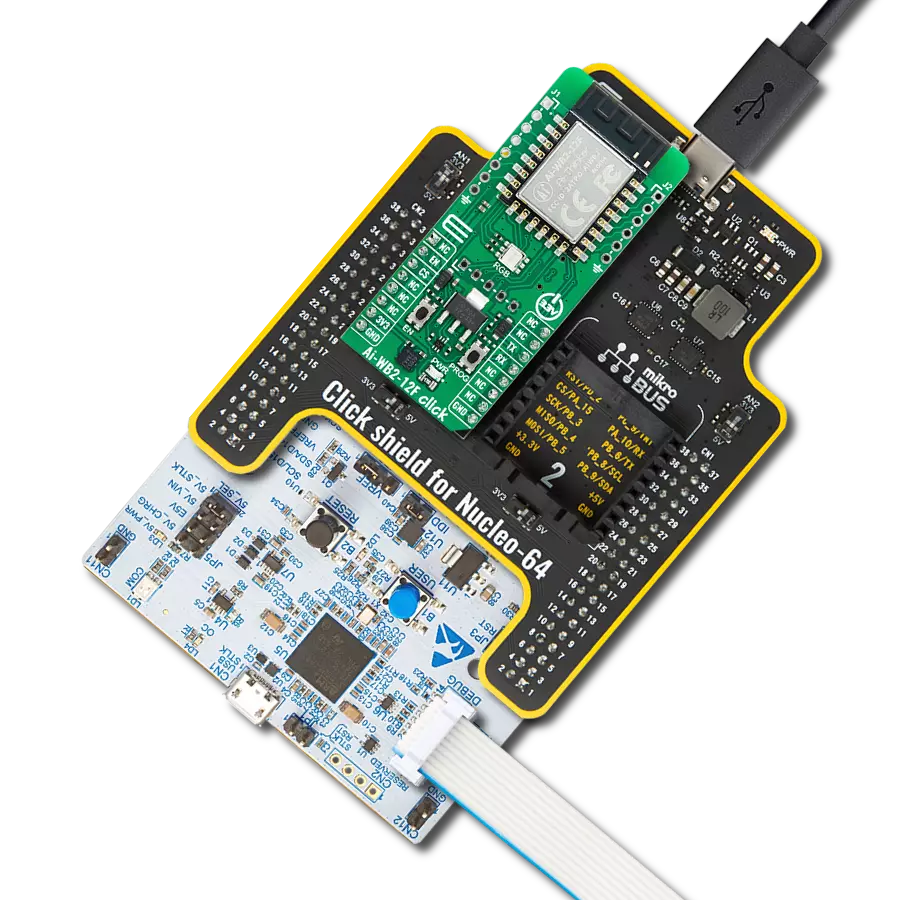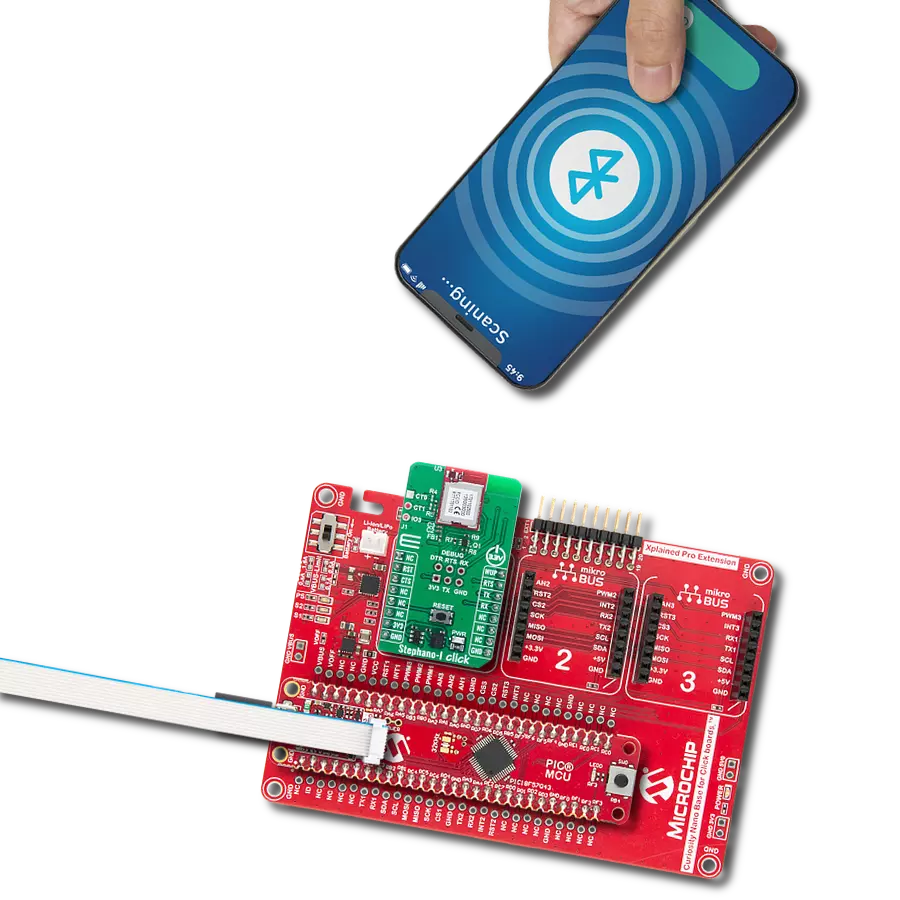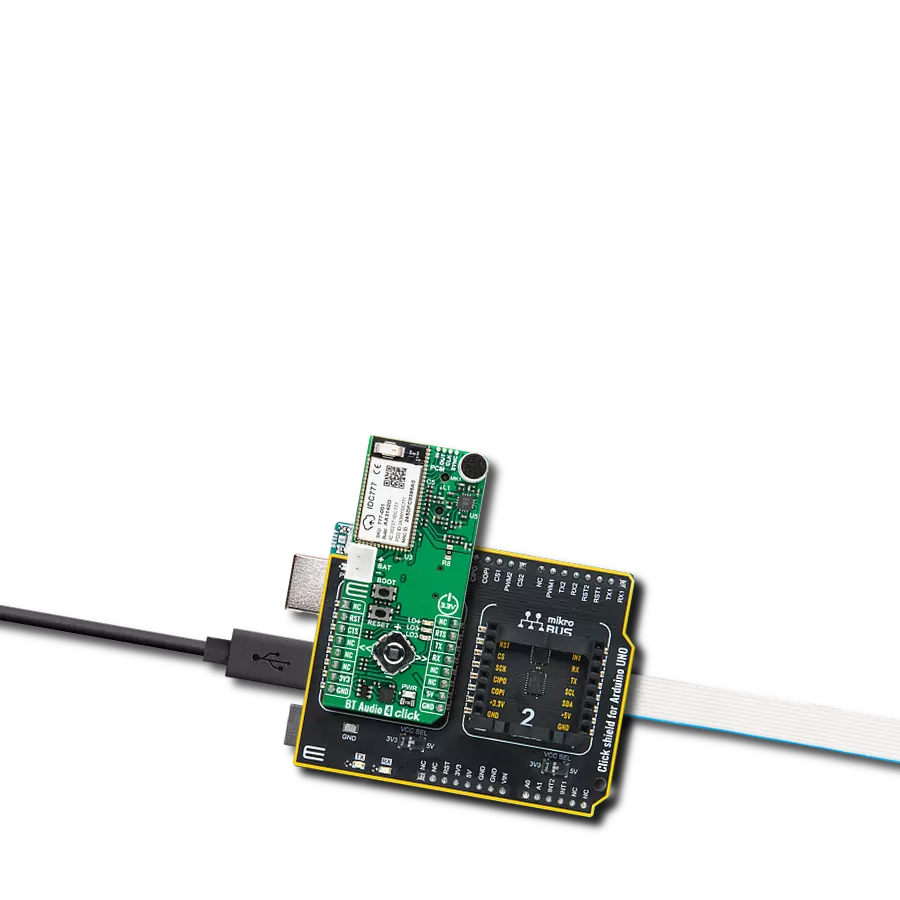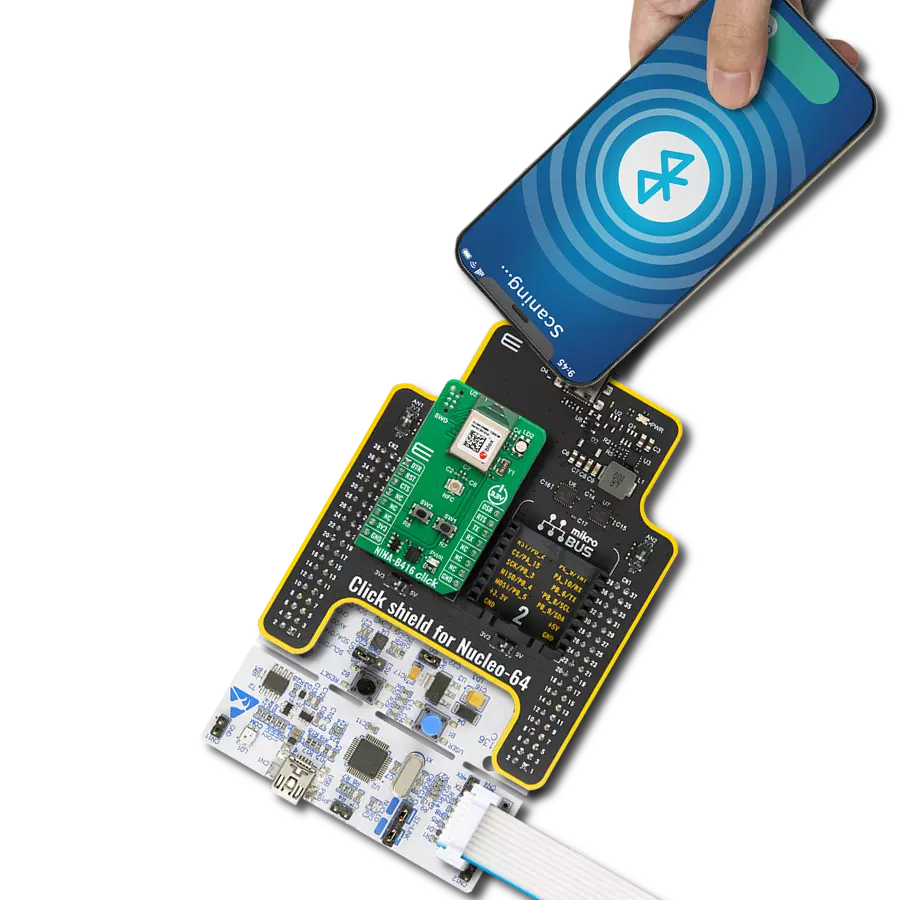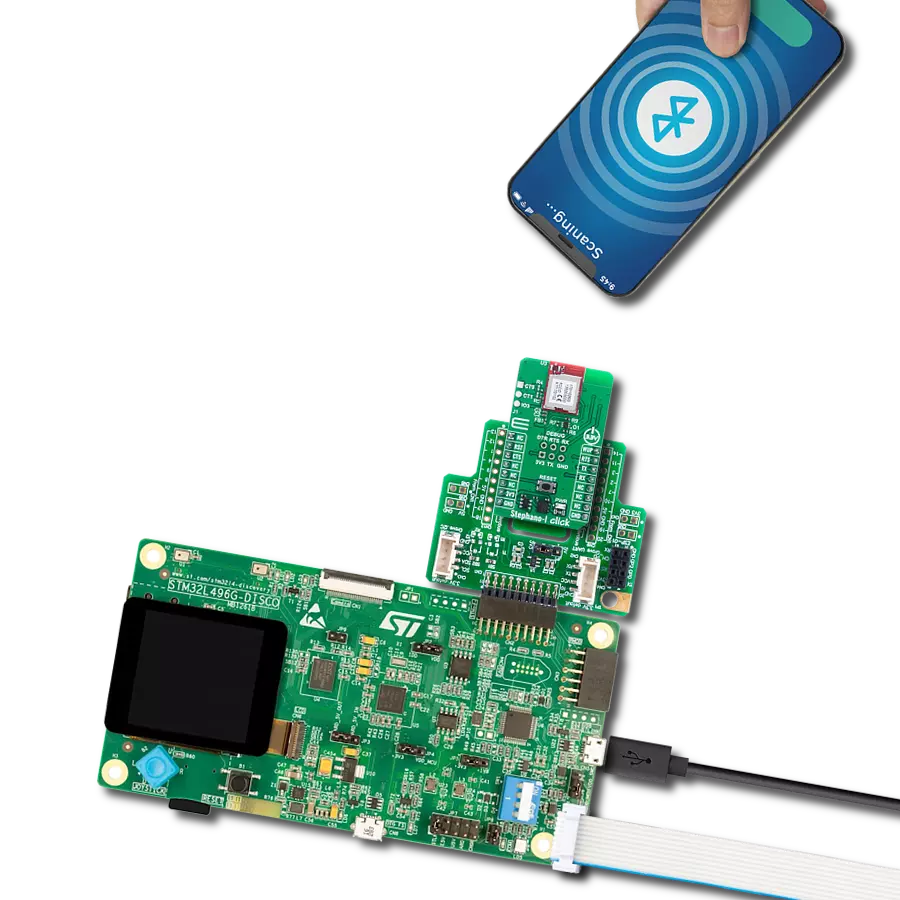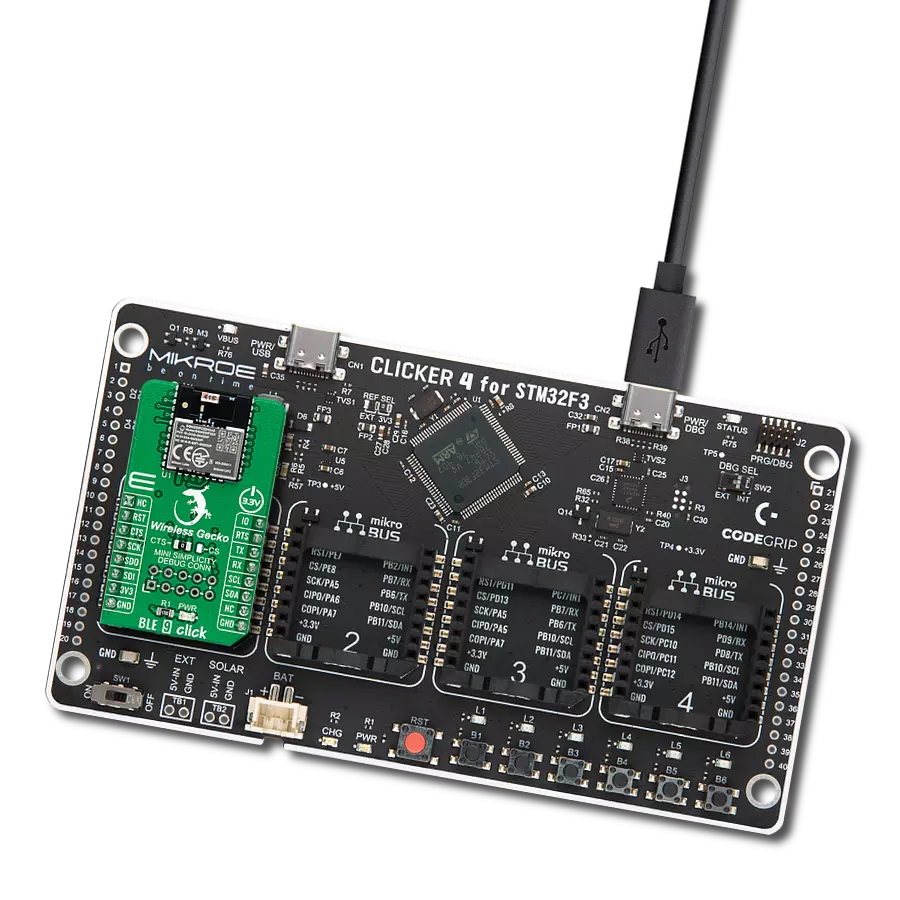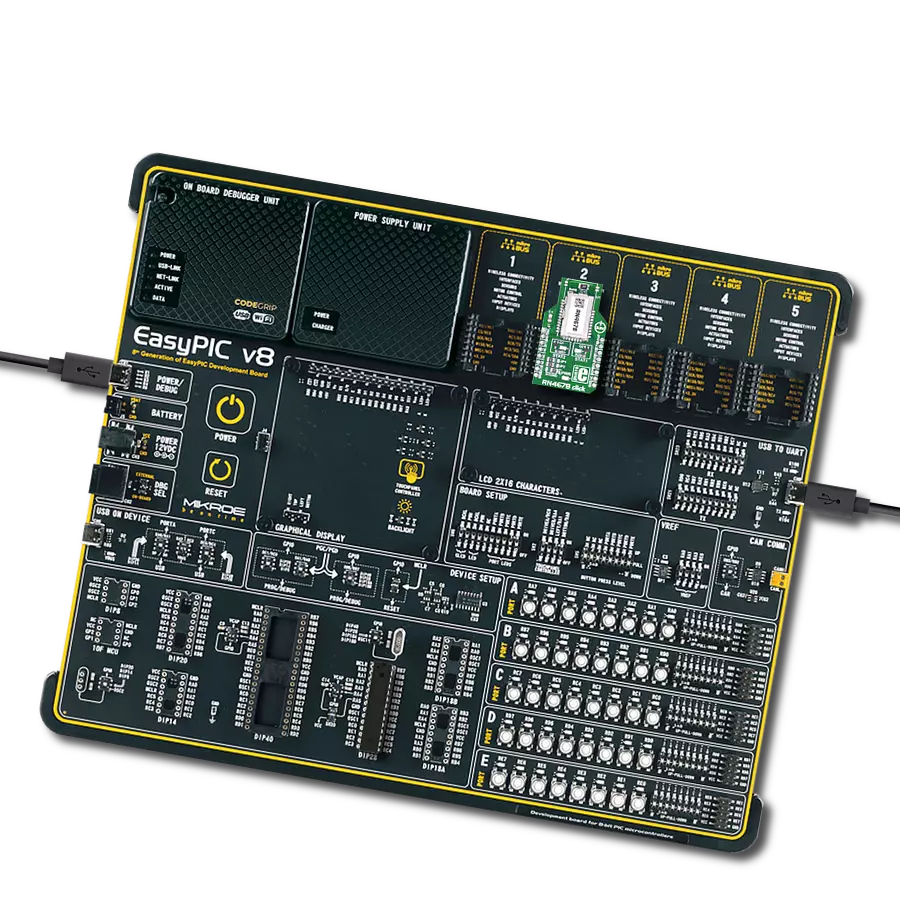Explore how this wireless method serves as a convenient alternative to cables, empowering users with effortless data exchange and intuitive device management for enhanced connectivity and productivity
A
A
Hardware Overview
How does it work?
RN4678 Click is based on the RN4678, a Bluetooth® 4.2 dual-mode module from Microchip. This Click is designed to run on a 3.3V power supply. It communicates with the target microcontroller over I2C and UART interface, with additional functionality provided by the following pins on the mikroBUS™ line: AN, RST, CS, PWM, INT. The RN4678 from Microchip is a fully certified Bluetooth version 4.2 module. Use it to add Bluetooth wireless capability to your project.
The module includes an onboard Bluetooth stack, power management subsystem, 2.4 GHz transceiver, and RF power amplifier. Data transfer is achieved through Bluetooth by sending or receiving data through SPP in Bluetooth (BT) Classic mode and Transparent UART in BLE mode. The RN4678 contains an integral ceramic chip antenna. The RN4678 module has strong AES128 Encryption. 128-bit encryption is one of the most robust encryption algorithms. AES stands for
Advanced Encryption Standard, a symmetric encryption algorithm. This Click board™ can be operated only with a 3.3V logic voltage level. The board must perform appropriate logic voltage level conversion before using MCUs with different logic levels. Also, it comes equipped with a library containing functions and an example code that can be used, as a reference, for further development.
Features overview
Development board
PIC18F57Q43 Curiosity Nano evaluation kit is a cutting-edge hardware platform designed to evaluate microcontrollers within the PIC18-Q43 family. Central to its design is the inclusion of the powerful PIC18F57Q43 microcontroller (MCU), offering advanced functionalities and robust performance. Key features of this evaluation kit include a yellow user LED and a responsive
mechanical user switch, providing seamless interaction and testing. The provision for a 32.768kHz crystal footprint ensures precision timing capabilities. With an onboard debugger boasting a green power and status LED, programming and debugging become intuitive and efficient. Further enhancing its utility is the Virtual serial port (CDC) and a debug GPIO channel (DGI
GPIO), offering extensive connectivity options. Powered via USB, this kit boasts an adjustable target voltage feature facilitated by the MIC5353 LDO regulator, ensuring stable operation with an output voltage ranging from 1.8V to 5.1V, with a maximum output current of 500mA, subject to ambient temperature and voltage constraints.
Microcontroller Overview
MCU Card / MCU
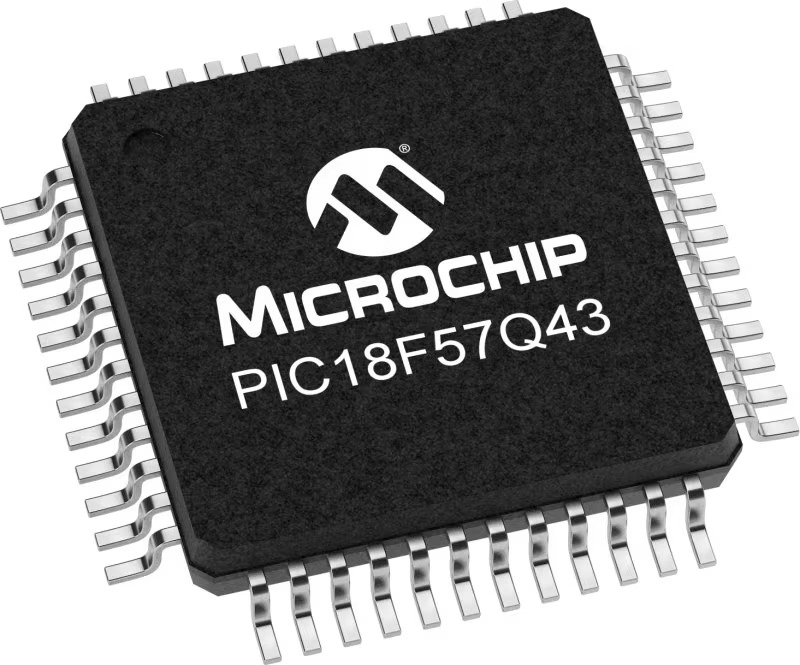
Architecture
PIC
MCU Memory (KB)
128
Silicon Vendor
Microchip
Pin count
48
RAM (Bytes)
8196
You complete me!
Accessories
Curiosity Nano Base for Click boards is a versatile hardware extension platform created to streamline the integration between Curiosity Nano kits and extension boards, tailored explicitly for the mikroBUS™-standardized Click boards and Xplained Pro extension boards. This innovative base board (shield) offers seamless connectivity and expansion possibilities, simplifying experimentation and development. Key features include USB power compatibility from the Curiosity Nano kit, alongside an alternative external power input option for enhanced flexibility. The onboard Li-Ion/LiPo charger and management circuit ensure smooth operation for battery-powered applications, simplifying usage and management. Moreover, the base incorporates a fixed 3.3V PSU dedicated to target and mikroBUS™ power rails, alongside a fixed 5.0V boost converter catering to 5V power rails of mikroBUS™ sockets, providing stable power delivery for various connected devices.
Used MCU Pins
mikroBUS™ mapper
Take a closer look
Click board™ Schematic

Step by step
Project assembly
Track your results in real time
Application Output
1. Application Output - In Debug mode, the 'Application Output' window enables real-time data monitoring, offering direct insight into execution results. Ensure proper data display by configuring the environment correctly using the provided tutorial.

2. UART Terminal - Use the UART Terminal to monitor data transmission via a USB to UART converter, allowing direct communication between the Click board™ and your development system. Configure the baud rate and other serial settings according to your project's requirements to ensure proper functionality. For step-by-step setup instructions, refer to the provided tutorial.

3. Plot Output - The Plot feature offers a powerful way to visualize real-time sensor data, enabling trend analysis, debugging, and comparison of multiple data points. To set it up correctly, follow the provided tutorial, which includes a step-by-step example of using the Plot feature to display Click board™ readings. To use the Plot feature in your code, use the function: plot(*insert_graph_name*, variable_name);. This is a general format, and it is up to the user to replace 'insert_graph_name' with the actual graph name and 'variable_name' with the parameter to be displayed.

Software Support
Library Description
This library contains API for RN4678 Click driver.
Key functions:
rn4678_enter_command_mode- Enter the command mode functionrn4678_exit_command_mode- Exit the command mode functionrn4678_set_device_name- Set the device name function
Open Source
Code example
The complete application code and a ready-to-use project are available through the NECTO Studio Package Manager for direct installation in the NECTO Studio. The application code can also be found on the MIKROE GitHub account.
/*!
* \file
* \brief RN4678 Click example
*
* # Description
* This example reads and processes data from RN4678 Clicks.
*
* The demo application is composed of two sections :
*
* ## Application Init
* Initializes the driver and configures the Click board.
*
* ## Application Task
* Checks for the received data, reads it and replies with a certain message.
*
* ## Additional Function
* - rn4678_process ( ) - Logs all the received messages/responses on the USB UART,
* and if it receives "Hello" string it sends the certain message
* back to the connected device.
*
* @note
* We have used the Serial Bluetooth Terminal smartphone application for the test.
* A smartphone and the Click board must be paired in order to exchange messages with each other.
*
* \author MikroE Team
*
*/
// ------------------------------------------------------------------- INCLUDES
#include "board.h"
#include "log.h"
#include "rn4678.h"
#include "string.h"
#define PROCESS_COUNTER 20
#define PROCESS_RX_BUFFER_SIZE 100
#define PROCESS_PARSER_BUFFER_SIZE 100
#define PROCESS_RSP_ERROR -1
#define PROCESS_RSP_OK 1
#define PROCESS_NO_RSP 0
#define PROCESS_LOG_RSP 0
// ------------------------------------------------------------------ VARIABLES
static rn4678_t rn4678;
static log_t logger;
uint8_t DEVICE_NAME_DATA[ 20 ] = { 'R', 'N', '4', '6', '7', '8', ' ', 'c', 'l', 'i', 'c', 'k' };
uint8_t EXTENDED_STRING_DATA[ 10 ] = { 'S', 'l', 'a', 'v', 'e' };
uint8_t PIN_CODE_DATA[ 10 ] = { '1', '2', '3', '4' };
static char current_parser_buf[ PROCESS_PARSER_BUFFER_SIZE ];
// ------------------------------------------------------- ADDITIONAL FUNCTIONS
static int8_t rn4678_process ( char * response )
{
int32_t rsp_size;
uint16_t rsp_cnt = 0;
char uart_rx_buffer[ PROCESS_RX_BUFFER_SIZE ] = { 0 };
uint8_t check_buf_cnt;
uint8_t process_cnt = PROCESS_COUNTER;
int8_t rsp_flag = 0;
// Clear current buffer
memset( current_parser_buf, 0, PROCESS_PARSER_BUFFER_SIZE );
while( process_cnt != 0 )
{
rsp_size = rn4678_generic_read( &rn4678, uart_rx_buffer, PROCESS_RX_BUFFER_SIZE );
if ( rsp_size > 0 )
{
// Validation of the received data
for ( check_buf_cnt = 0; check_buf_cnt < rsp_size; check_buf_cnt++ )
{
if ( uart_rx_buffer[ check_buf_cnt ] == 0 )
{
uart_rx_buffer[ check_buf_cnt ] = 13;
}
}
// Storages data in current buffer
rsp_cnt += rsp_size;
if ( rsp_cnt < PROCESS_PARSER_BUFFER_SIZE )
{
strncat( current_parser_buf, uart_rx_buffer, rsp_size );
}
// Clear RX buffer
memset( uart_rx_buffer, 0, PROCESS_RX_BUFFER_SIZE );
if ( strstr( current_parser_buf, "ERR" ) ) {
Delay_100ms( );
rsp_flag = PROCESS_RSP_ERROR;
break;
}
if ( PROCESS_LOG_RSP != response )
{
if ( strstr( current_parser_buf, response ) ) {
Delay_100ms( );
rsp_flag = PROCESS_RSP_OK;
break;
}
}
else
{
rsp_flag = PROCESS_RSP_OK;
process_cnt = 1;
}
if ( strstr( current_parser_buf, "Hello" ) ) {
rn4678_generic_write( &rn4678, "MikroE\r\n", 8 );
Delay_100ms( );
break;
}
}
else
{
process_cnt--;
// Process delay
Delay_ms ( 100 );
}
}
if ( PROCESS_NO_RSP != rsp_flag )
{
log_printf( &logger, "%s", current_parser_buf );
log_printf( &logger, "\r\n---------------------------\r\n" );
return rsp_flag;
}
return PROCESS_NO_RSP;
}
// ------------------------------------------------------ APPLICATION FUNCTIONS
void application_init ( void )
{
log_cfg_t log_cfg;
rn4678_cfg_t cfg;
/**
* Logger initialization.
* Default baud rate: 115200
* Default log level: LOG_LEVEL_DEBUG
* @note If USB_UART_RX and USB_UART_TX
* are defined as HAL_PIN_NC, you will
* need to define them manually for log to work.
* See @b LOG_MAP_USB_UART macro definition for detailed explanation.
*/
LOG_MAP_USB_UART( log_cfg );
log_init( &logger, &log_cfg );
log_info( &logger, "---- Application Init ----" );
// Click initialization.
rn4678_cfg_setup( &cfg );
RN4678_MAP_MIKROBUS( cfg, MIKROBUS_1 );
rn4678_init( &rn4678, &cfg );
rn4678_enable ( &rn4678 );
Delay_ms ( 1000 );
rn4678_hw_reset ( &rn4678 );
Delay_ms ( 1000 );
log_printf( &logger, "Configuring the module...\n" );
do
{
log_printf( &logger, " --- Command mode --- \r\n" );
rn4678_enter_command_mode( &rn4678 );
}
while( rn4678_process( "CMD" ) != 1 );
do
{
log_printf( &logger, " --- Device name --- \r\n" );
rn4678_set_device_name( &rn4678, &DEVICE_NAME_DATA[ 0 ] );
}
while( rn4678_process( "AOK" ) != 1 );
do
{
log_printf( &logger, " --- Status string --- \r\n" );
rn4678_set_extended_status_string( &rn4678, &EXTENDED_STRING_DATA[ 0 ] );
}
while( rn4678_process( "AOK" ) != 1 );
do
{
log_printf( &logger, " --- Operating mode --- \r\n" );
rn4678_set_operating_mode( &rn4678, 0 );
}
while( rn4678_process( "AOK" ) != 1 );
do
{
log_printf( &logger, " --- Authentication --- \r\n" );
rn4678_set_authentication( &rn4678, 1 );
}
while( rn4678_process( "AOK" ) != 1 );
do
{
log_printf( &logger, " --- Pin code --- \r\n" );
rn4678_set_security_pin_code( &rn4678, &PIN_CODE_DATA[ 0 ] );
}
while( rn4678_process( "AOK" ) != 1 );
do
{
log_printf( &logger, " --- Exit command mode --- \r\n" );
rn4678_exit_command_mode( &rn4678 );
}
while( rn4678_process( "END" ) != 1 );
log_printf( &logger, "The module has been configured.\n" );
rn4678_set_cts_pin( &rn4678, 0 );
}
void application_task ( void )
{
rn4678_process( PROCESS_LOG_RSP );
}
int main ( void )
{
/* Do not remove this line or clock might not be set correctly. */
#ifdef PREINIT_SUPPORTED
preinit();
#endif
application_init( );
for ( ; ; )
{
application_task( );
}
return 0;
}
// ------------------------------------------------------------------------ END
Additional Support
Resources
Category:BT/BLE



















